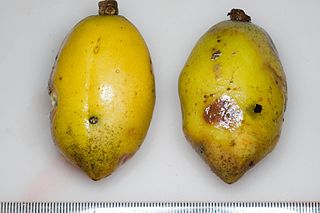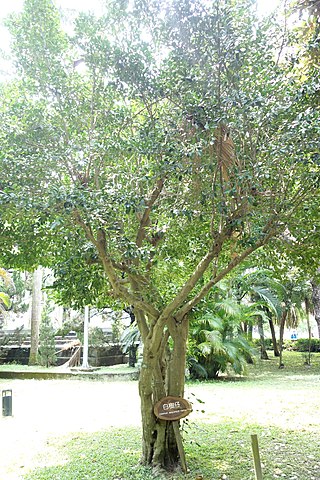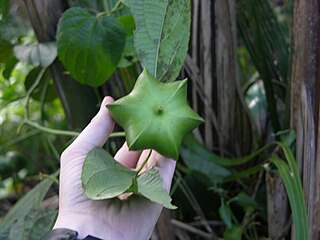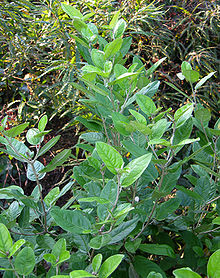
The Nymphalidae are the largest family of butterflies, with more than 6,000 species distributed throughout most of the world. Belonging to the superfamily Papilionoidea, they are usually medium-sized to large butterflies. Most species have a reduced pair of forelegs and many hold their colourful wings flat when resting. They are also called brush-footed butterflies or four-footed butterflies, because they are known to stand on only four legs while the other two are curled up; in some species, these forelegs have a brush-like set of hairs, which gives this family its other common name. Many species are brightly coloured and include popular species such as the emperors, monarch butterfly, admirals, tortoiseshells, and fritillaries. However, the under wings are, in contrast, often dull and in some species look remarkably like dead leaves, or are much paler, producing a cryptic effect that helps the butterflies blend into their surroundings.

Phyllanthaceae is a family of flowering plants in the eudicot order Malpighiales. It is most closely related to the family Picrodendraceae.

The family Pandaceae consists of three genera that were formerly recognized in the Euphorbiaceae. Those are:

The Acalyphoideae are a subfamily within the family Euphorbiaceae with 116 genera in 20 tribes.

The Euphorbioideae are a subfamily within the family Euphorbiaceae.

Adenoclineae is a tribe of the subfamily Crotonoideae, under the family Euphorbiaceae. It comprises 2 subtribes and 6 genera.

Aleuritideae is a tribe of the subfamily Crotonoideae, under the family Euphorbiaceae. It comprises 6 subtribes and 14 genera.

Codiaeae is a tribe of the subfamily Crotonoideae, under the family Euphorbiaceae. It comprises 15 genera.

Gelonieae is a flowering plant of tribe of the subfamily Crotonoideae, under the family Euphorbiaceae. It comprises 2 genera.

The Jatropheae are a tribe of the subfamily Crotonoideae, under the family Euphorbiaceae. It comprises eight genera.

Manihoteae is a tribe of the subfamily Crotonoideae, under the family Euphorbiaceae. It comprises 2 genera.

Micrandreae is a tribe of the subfamily Crotonoideae, under the family Euphorbiaceae. It comprises 2 subtribes and 4 genera.
Ricinocarpeae is a tribe of the subfamily Crotonoideae, under the family Euphorbiaceae. It comprises 2 subtribes and 7 genera.

Ricinodendreae is a tribe of the subfamily Crotonoideae, under the family Euphorbiaceae. It comprises 3 genera.

Plukenetieae is a tribe of plant of the family Euphorbiaceae. It comprises 3 subtribes and 14 genera. Tribe Plukenetieae (Benth.) Hutch. is a diverse pantropical lineage of ca. 17 genera and 350 species of twining vines and lianas, scandent to erect perennial herbs and subshrubs, and rarely shrubs and small trees.
Käthe Hoffmann was a German botanist who described many plant species in New Guinea and South East Asia including Annesijoa novoguineensis. She was a professor at Breslau, German Empire, and made a significant contribution to botany. In one study, she was found to have co-authored or authored 354 land plant species, the sixth-highest number authored by any female scientist. As of May 2020, Plants of the World Online lists 439 accepted genera and species which include Käthe Hoffmann in the authority, in some capacity.

Euphorbiaceae, the spurge family, is a large family of flowering plants. In English, they are also commonly called euphorbias, which is also the name of the type genus of the family. Most spurges, such as Euphorbia paralias, are herbs, but some, especially in the tropics, are shrubs or trees, such as Hevea brasiliensis. Some, such as Euphorbia canariensis, are succulent and resemble cacti because of convergent evolution. This family has a cosmopolitan global distribution. The greatest diversity of species is in the tropics; however, the Euphorbiaceae also have many species in nontropical areas of all continents except Antarctica.
Plukenetia conophora, also called Nigerian walnut, and conophore, is a climbing shrub in the genus Plukenetia. It is not related to the walnut, being so named because its nuts bear a superficial resemblance to the walnut. It is native to tropical western and central Africa from Togo to Congo and in Sierra Leone. It is abundant in the Nigeria, Cameroon, Republic of the Congo and Democratic Republic of Congo. It prefers rain-forest hedge in half-shady places; low bush; secondary forest; plantations at elevations from 250–1,400 m (820–4,590 ft). Although it is well recorded in Sierra Leone, it is apparently not indigenous to Sierra Leone, since it is not recorded in Liberia and Ghana. Its presence in Sierra Leone is due to returning slaves for it is known to the Krio by its Yoruba (Nigerian) name. Plukenetia conophora is the only Plukenetia species native to West Africa or Central Africa. Other Plukenetia species are indigenous to other parts of Africa, the Indian Subcontinent, Southeast Asia, and America.















